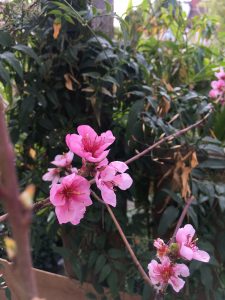A few years ago I moved my dwarf nectarine into the greenhouse, and it is at this moment in the year that I am glad I did. My nectarine is a dwarf variety, and has lived in a pot out of doors for many years, and so I am lucky that it is moveable. It has been healthier and produced more fruit since we moved it in, and this is for a couple of reasons, one of which becomes very apparent right now. As the leaves start to emerge in spring, nectarines and peaches are vulnerable to ‘peach leaf curl’. This is a fungus that is carried on spring rains, and if it falls on your leaves as they start to grow it will infect them. They then curl as they grow, and turn shades of scarlet and orange. This severely cuts down the plant’s ability to photosynthesise and therefore reduces its ability to grow, flower and set fruit. A bad infestation can eventually kill a plant, and you will certainly see fewer fruits on a plant that is infected with it.
But the solution is as simple as keeping the rain off of the leaves during these crucial few weeks. You can do this by constructing a shelter – particularly possible where peaches and nectarines are fan-trained against a wall – or even just by throwing a piece of horticultural fleece over the plant if it is in the ground. But if it is in a pot then you can move it, either under the eaves of the house so that less rain falls on the leaves or – as I have – into the greenhouse.

In theory I could move it back outdoors once this early spring period is past, but there are other good reasons for keeping it indoors. Peaches and nectarines obviously thrive in warm and sunny climates – there are very good reasons why the UK is not a great centre of peach and nectarine production, while Italy, Spain and Greece are. They have the reliable sunshine and warmth that we do not have. But of course these are things that a greenhouse can replicate – if not the sunshine then at least the warmth. A peach or nectarine growing in the shelter of a greenhouse – even an unheated one – will have a much greater opportunity to bring fruits to maturity. They are likely to be larger and sweeter too than those grown outside.
There are a couple of things you need to watch for though if you are growing any fruit trees under cover. The first is coming up shortly, and it is pollination. Peaches and nectarines both blossom early in the year, and even outdoors it is a good idea to help them along with pollination, as there are not yet very many pollinating insects around. Indoors there are none. The trick is to take a soft paintbrush and just gently brush the centre of a flower, which picks up pollen from the stamens. Then move on the next flower and do it again – this transfers the pollen to the next flower. Do this all over the plant.
You will also need to feed and water the plant all spring and summer. A high potassium feed such as tomato fertiliser is a good choice for this, as it contains the nutrients to support flowering and fruiting. Take particular care to water the plant a lot later in the summer as the fruits swell and ripen, and try to ensure watering is even – if you allow the pot to dry out and then soak it, the skins can harden and then split as the fruit swells. With a little bit of care though, and a dwarf variety in a pot, a greenhouse can be the ideal spot for growing these delicious fruits.


